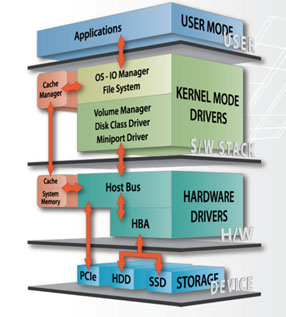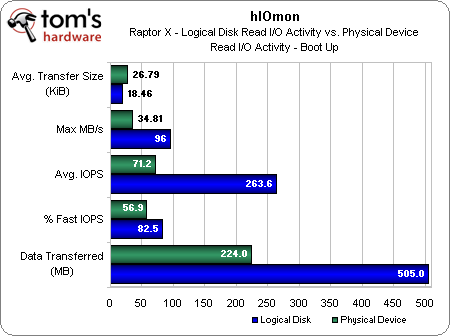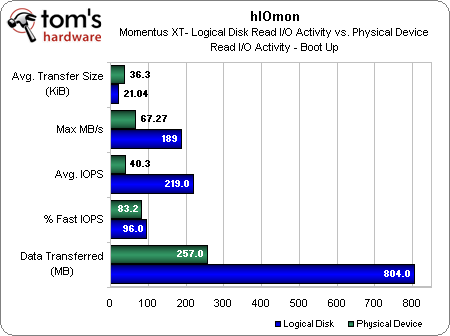In The Lab With Seagate's Momentus XT 750 GB Hybrid HDD
More than two years after reviewing Seagate's first-generation Momentus XT, we're back in the lab with a 750 GB model armed with 8 GB of SLC NAND and a SATA 6Gb/s interface. How does it compare to pure solid-state and hard drive technologies? We dig deep.
Benchmark Results: Boot-Up In hIOmon
Based on the preceding page's ASU benchmarks, Seagate's Momentus XT looks a lot more promising. But let’s first consider how synthetics translate to the real-world before getting too ahead of ourselves.
For this, we're using hIOmon, a file and disk I/O performance measuring tool that can concurrently monitor I/O operation activity within three distinct levels of the software and hardware stack: namely, the logical disk level (the file system), the physical volume level, and the physical device level. The image below helps visualize each level of the stack, and it comes from a SNIA webcast that discusses the complexities of how I/Os traverse the stack. You can find that webcast here.
Monitoring results from the logical disk level are obtained between the operating system I/O manager and the file system. Results from the physical volume level are gleaned between the file system and the volume manager, and results from the physical device come from in between the volume manager and the disk class driver.
The difference in I/O activity between the logical disk level and the physical disk can vary significantly. In the graphs below, we capture data from the latter portion of the boot-up process. Booting up consists of a number of stages, starting with a power-on self-test, proceeding on to the BIOS ROM and boot loader phase, and then the firing-up of various configured services and other start-up tasks.
hIOmon is normally configured to begin monitoring once the services start to load (hIOmon can optionally be configured to begin monitoring earlier in the process). Due to the dynamic nature of the boot process, the measurements taken can vary significantly from run to run, which is evident from our results below. The largest variation occurs at the logical disk level.
Although the difference in the amount of data transferred is quite significant, it does not (in this case) have a significant impact on the percentage of fast IOPS or the average block transfer size. To clarify, a fast I/O is an operation observed by hIOmon to have completed in less than one millisecond.
The boot-up processes that we monitored typically consist of approximately 88% random read access and 12% sequential read access, with an average queue depth of 1.4.
Get Tom's Hardware's best news and in-depth reviews, straight to your inbox.
If there's one key take-away, it's that a significant amount of I/O activity can occur independent of the storage device, which significantly reduces demands made on the storage system. As a result, the potentially poor performance of a storage solution can be masked to a degree. This is evident in the increased percentage of fast IOPS and the higher maximum transfer rate achieved at the logical disk level when we monitor Western Digital's Raptor X.
When we monitor the Momentus XT's boot-up process, we see that performance increases at both the logical disk and physical device level for both the percentage of fast IOPS and the maximum transfer rate.
On Samsung's 830, the percentage of fast IOPS is identical at both the logical disk and physical device levels. Meanwhile, the maximum transfer rate increases at each level.
Current page: Benchmark Results: Boot-Up In hIOmon
Prev Page Benchmark Results: Anvil's Storage Utility Next Page Benchmark Results: Boot Time And Game Level Loading-
sunsmasher So it sounds like the hot setup is SSD for OS/Apps, and HHDD for storage of frequently used media, with a 2TB+ hard drive for storage/archiving of other media.Reply -
americanbrian I don't like your spider graph for reliability.... Does the Hybrid Drive still "work" when either the flash or spinning discs fail?Reply
If not (which it is easy to argue it would at least not be working properly if at all). Then you must say it has twice the chance at failure. This is because if there is a 1:1000 chance of the HD part failing, and a 1:1000 cahnce of the flash failing (your spider shows them to be roughly equal) then there is a 2:1000 chance of "drive" failure in total (or 1:500).
That is called "probability" it is funny like that. Think of it like a weird RAID 0 array. -
hunshiki The idea is great in my opinion, but they could include a 16gb SSD inside the drive. Or 32.Reply -
akamrcrack Would have been nice to see you include SSD caching drives like the Crucial Adrenaline in this study.Reply
My Adrenaline + Samsung Spinpoint F3 1TB 7200rpm HDD say they are the better buys :)
Installed my OS onto my HDD (was originally on a Crucial M4 64GB) then installed the Caching software from Dataplex and watched the sparks fly!
Now my Spinpoint runs as fast as my Intel 320 series 120GB SSD in CrystalDiskMark :)
Plus I can always upgrade to a 2TB HDD meaning I can have 2TB of space running at SSD speeds all day :)
When you are a srs gamer like me and you have hundreds of games to store and no SSD capable of holding them, you begin to want to find solutions to solve that. Well ever since I installed the caching drive + software (very simple) everything about my HDD is fast!
Momentus is old and tried. The only thing I know of that can match the performance of my HDD+SSD cache is a new gen velociraptor 1TB HDD that costs around $320. Which could get me 2TB of storage and the SSD cache and still have money left over lol so neither new gen raptors or momentus are worth the cost unless you are limited to 1x 3.5" bay in your computer.. Even then a 2.5" SSD is very easy to hide in a case..
I've seen the argument "why not just get a regular SSD instead of the Adrenaline, won't they do the same thing?"
My response to that is, for the average user that wants simplicity getting a SSD premade for caching that comes with quality software is the way to go. The Dataplex software is very very light and as simple as install then forget it existed. -
A comparison with Intel's SRT technology (combines up to 64GB SSD with a traditional HD) would have been interesting. I wonder what evidence made Intel choose 64GB and Seagate choose 8GB? What is the optimal amount of SSD to pair with an HD generally speaking?Reply
-
mariusmotea To test a Hybrid drive you need to use it several hours. of course that benchmarks files has been cached into the SSD. Let's see the startul speed after i browse the internet for few hours and play a game for 30 minutes. I don't belive that the statup files will be in ssd anymore.Reply -
dthx Of course a SSD + big 3.5 drive is always a better solution but... impossible to achieve in most portable PC's. This is where the hybrid shines: you don't have to choose between decent performances and sufficient and affordable capacity. I've put such a drive (and Win7 instead of Vista) in a 4 year old XPS-1330 and after a few reboots it has become an extremely capable machine (faster than any brand new laptop with a conventional HDD).Reply -
cscott_it I recall another site (maybe Anandtech?) putting a couple of these in a RAID 0 configuration and the performance scaled rather nicely. Any chance you guys are thinking about doing something like that?Reply



